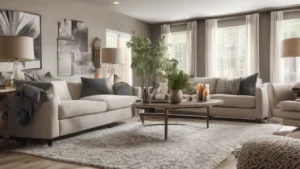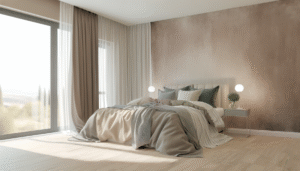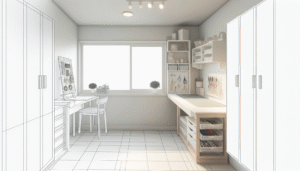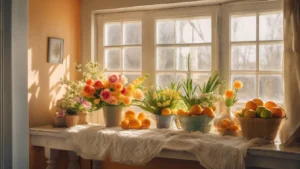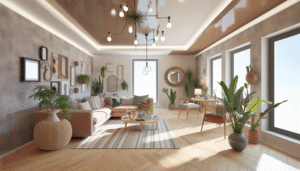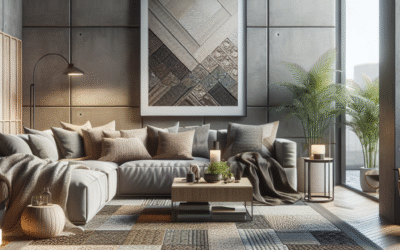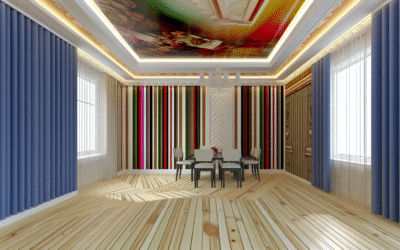
Stepping into a home should feel like a deep breath, a moment of calm in our increasingly hectic lives. But how often do our living spaces truly deliver on that promise? Clutter, disconnected design, and overwhelming aesthetics often leave us feeling more agitated than at peace. This is where the profound tranquility of Japandi style floor design ideas steps in, offering a unique blend of Japanese Zen and Scandinavian minimalism to create truly serene environments. It’s not just about aesthetics; it’s about crafting a feeling, a philosophy ingrained into every plank, tile, or polished concrete surface.
Imagine clean lines, natural materials, and an effortless flow that guides you through your home. The Japandi aesthetic, particularly in its approach to flooring, prioritizes functionality, durability, and understated beauty. No flashy distractions, no excessive patterns – just pure, refined elegance that supports a clutter-free lifestyle and fosters mindfulness. This comprehensive guide will immerse you in the world of Japandi style minimalist floor design ideas, from selecting the perfect materials to understanding crucial installation considerations. We’ll explore how to achieve an aesthetic that isn’t just visually appealing, but that deeply resonates with your desire for a calm, balanced living space. Prepare to transform your floors into foundations of tranquility.
Here’s what we’ll cover:
- Understanding the Core Principles of Japandi Flooring
- Key Materials for Authentic Japandi Floors
- Color Palettes and Finishes for Minimalist Impact
- Integrating Japandi Flooring with Overall Home Design
- Practical Considerations for Durability and Maintenance
- Advanced Techniques for Elevating Your Japandi Floor
- Common Questions About Japandi Flooring
Understanding the Core Principles of Japandi Flooring
Before diving into specific Japandi style minimalist floor design ideas, it’s essential to grasp the foundational philosophies that guide this hybrid aesthetic. Japandi isn’t merely a decorative trend; it’s a lifestyle choice, a celebration of simplicity, natural beauty, and functional harmony. When it comes to flooring, these principles translate into deliberate choices that foster a sense of peace and order.
The Harmony of Wabi-Sabi and Lagom
At the heart of Japandi design are two distinct yet complementary philosophies: the Japanese concept of Wabi-Sabi and the Scandinavian principle of Lagom.
- Wabi-Sabi (侘寂): This Japanese aesthetic finds beauty in imperfection, transience, and natural simplicity. It appreciates the authentic, the worn, the weathered, recognizing the inherent beauty in natural materials and their aging process. For flooring, this means embracing the grain of wood, the slight variations in stone, or the subtle textures that emerge over time. It’s about eschewing artificial perfection for genuine character.
- Lagom (🇸🇪): A Swedish word meaning “just enough,” or “in moderation,” Lagom champions balance and functionality. It rejects excess, promoting practicality and conscious consumption. In Japandi flooring, this translates to choosing durable, high-quality materials that serve their purpose without unnecessary embellishment. It’s about finding the sweet spot between too much and too little, creating a balanced and comfortable environment.
By merging these two, Japandi flooring achieves a unique warmth and groundedness. It’s minimalist, yet never stark; simple, yet deeply rich in character.
Functionality Meets Form: The Practicality of Japandi Floors
A core tenet of Japandi design is that every element must serve a purpose. Floors are not just visual foundations; they are functional surfaces that support daily life. This philosophy drives material selection towards durability, ease of maintenance, and comfort underfoot. A beautiful floor that scratches easily or requires constant, complex upkeep contradicts the very essence of Japandi tranquility.
Consider the daily rituals in your home. Do children play on the floor? Do pets roam freely? Is it a high-traffic area? Japandi style minimalist floor design ideas are not about sacrificing practicality for aesthetics, but rather finding materials that excel in both. Options like engineered wood, polished concrete, or certain tile varieties offer robust performance alongside their inherent beauty.
Embracing Natural Materials and Textures
Synthetic materials that mimic natural ones are generally avoided in authentic Japandi design. The true beauty lies in the real thing. Wood, stone, and natural fibers are celebrated for their inherent textures, variations, and ability to connect us to the natural world.
Think about the tactile experience: the warmth of wood beneath bare feet, the cool solidity of stone, or the subtle texture of woven mats. These elements contribute to a multi-sensory environment that promotes relaxation and a deeper connection to nature. When exploring Japandi style minimalist floor design ideas, prioritize materials that resonate with this natural ethos.
Key Materials for Authentic Japandi Floors
Selecting the right flooring material is paramount in achieving the serene and functional aesthetic of Japandi design. The choices are deliberate, favoring natural origins, understated beauty, and enduring quality. Let’s delve into the most popular and effective materials for your Japandi style minimalist floor design ideas.
1. Light-Toned Hardwood: The Foundation of Warmth
Hardwood flooring is arguably the quintessential choice for Japandi interiors, offering a timeless blend of warmth, durability, and natural elegance. The key here is the tone and finish.
- Species Choice: Opt for lighter woods like ash, birch, white oak, or maple. These species inherently possess a pale, understated grain that aligns perfectly with the minimalist palette.
- Finish: Matte or ultra-matte finishes are preferred over glossy ones. A matte finish allows the wood’s natural texture and grain to shine through without reflective distracting glare, contributing to a more organic, grounded feel. Light stains, or even natural clear finishes, are ideal to maintain the wood’s inherent lightness.
- Construction: Both solid hardwood and engineered hardwood are suitable. Engineered wood can be a more stable choice for areas with fluctuating humidity and offers wider plank options, which are aesthetically pleasing in Japandi spaces.
- Plank Width: Wide planks (6-8+ inches) are often favored in Japandi design. They create fewer seams, contributing to a more expansive, uninterrupted flow across the floor, enhancing the sense of spaciousness.
- Considerations: While beautiful, hardwood requires careful consideration for moisture-prone areas like bathrooms. Regular cleaning and occasional re-oiling/polishing are necessary to maintain its beauty.
2. Polished Concrete: Industrial Charm Meets Zen Calm
For those seeking a more contemporary interpretation of Japandi style minimalist floor design ideas, polished concrete offers an intriguing blend of industrial chic and serene simplicity. Its raw, unpretentious character aligns perfectly with Wabi-Sabi principles.
- Aesthetic: Concrete floors present a smooth, monolithic surface that embodies minimalist ideals. The subtle variations in tone and texture that naturally occur during the polishing process add depth without busyness.
- Color: Natural gray tones are most common, but concrete can also be stained or tinted with very subtle, earthy pigments to complement the Japandi palette.
- Benefits: Highly durable, incredibly easy to clean, and excellent for radiant heating systems. It’s also an eco-friendly option if existing concrete slabs are utilized.
- Considerations: Can feel cold underfoot if not paired with radiant heating. While durable, it can be unforgiving if objects are dropped. It also requires professional installation and sealing to prevent staining. The hard surface also means acoustic dampening measures (rugs, soft furnishings) become more important.
3. Large Format Tiles: Seamless and Serene
Tiles can certainly find a place in Japandi style minimalist floor design ideas, especially in areas where durability and moisture resistance are paramount, such as bathrooms, kitchens, and entryways. The key is in the size, color, and finish.
- Size: Opt for large format tiles (e.g., 24×24 inches or larger). Larger tiles mean fewer grout lines, which creates a more expansive, seamless look that mirrors the clean lines of Japandi aesthetics.
- Material: Porcelain stoneware or matte ceramic tiles are excellent choices. Look for tiles with naturalistic textures – subtle stone effects, concrete looks, or even very subdued wood-grain imitations with a matte finish.
- Color: Stick to the neutral Japandi palette: off-whites, warm grays, muted beiges, and soft earthy tones. Avoid high-contrast patterns or overly glossy finishes.
- Grout: Choose a grout color that closely matches the tile to minimize visual distraction and enhance the seamless appearance.
4. Woven Mats and Rugs: Adding Texture and Definition
While not a primary flooring material, natural fiber rugs and mats are integral to layering and defining spaces within a Japandi home, especially over hard surfaces like concrete or solid wood.
- Materials: Jute, sisal, wool, and natural cotton are perfect. These materials introduce organic texture and warmth.
- Design: Simple, unadorned designs are best. Think solid colors, subtle weaves, or understated geometric patterns (if any).
- Placement: Use them to anchor furniture groupings, delineate zones in open-plan spaces, or add a soft landing in bedrooms. They enhance comfort and acoustic quality without cluttering the visual field.
By thoughtfully combining these core materials, you can craft a foundation that not only looks beautiful but also perfectly embodies the functional elegance and serene atmosphere of Japandi style minimalist floor design ideas.
Color Palettes and Finishes for Minimalist Impact
The color palette and finishes applied to your floors are critical in defining the overall mood of a Japandi space. This aesthetic thrives on subtlety, restraint, and an intimate connection to natural tones. Adhering to a specific range of hues and textures ensures your Japandi style minimalist floor design ideas truly foster a sense of calm and openness.
The Japandi Neutral Palette: Earth and Sky
The Japandi color scheme is a carefully curated blend of muted tones drawn directly from the natural world. It avoids stark whites and harsh primary colors, instead opting for a softer, more grounded spectrum.
- Warm Neutrals: Think soft beiges, oatmeal, sand, and muted creams. These colors provide a gentle warmth, evoking the natural hue of untreated wood or dried grasses.
- Cool Neutrals: Gentle grays, from pale almost-white grays to deeper charcoal, offer a sophisticated coolness reminiscent of stone or cloud formations. These often derive from Scandinavian influence.
- Earthy Tones: Occasional deep greens, muted blues, or terracotta can be introduced as subtle accents, reflecting elements like foliage, water, or natural clay, but generally not on the main flooring surface.
- Black and White (Sparingly): True black is used very sparingly, perhaps as a furniture leg or a small decorative object, never as a dominant floor color. White is also typically an off-white, a creamier tone to soften its intensity.
When selecting flooring colors for your Japandi style minimalist floor design ideas, aim for hues that feel soft, breathable, and provide a neutral backdrop for the rest of your decor.
Finishes: Embracing the Matte Aesthetic
The finish of your floor is just as important as its color. Japandi design overwhelmingly favors matte surfaces over glossy ones for several compelling reasons:
- Reduces Glare: Matte finishes absorb rather than reflect light, creating a softer, more diffused ambiance. This contributes to the serene, unpreturbed look central to Japandi.
- Highlights Natural Texture: A matte finish allows the inherent texture of wood grain, the subtle variations in concrete, or the stone-like character of tiles to be truly appreciated. It feels more organic and less manufactured.
- Wabi-Sabi Connection: The natural, unadorned quality of a matte surface resonates strongly with Wabi-Sabi, which prizes authenticity and imperfection. It suggests a floor that is honest about its material.
- Hides Imperfections: Practically speaking, matte finishes tend to show scratches, dust, and scuff marks less readily than high-gloss surfaces, making them easier to maintain in a practical sense.
For wooden floors, this means opting for oil finishes, ultra-matte lacquers, or even raw, sealed wood looks. For tiles, look for unglazed or matte-glazed options. Polished concrete, while having a sheen, is distinct from a high-gloss epoxy coating, retaining a raw, minimalist character.
Contrast and Variation: Subtle Visual Interest
While the overall palette is muted, Japandi design isn’t devoid of visual interest. This comes through subtle contrasts and variations rather than bold statements.
- Wood Grain: The natural patterns within wood itself, particularly in wider planks, offer organic and subtle visual appeal.
- Material Mix: Combining a wooden floor with a natural fiber rug or concrete with raw wood furniture introduces textural contrast without color clash.
- Light and Shadow: The interplay of natural light across a matte floor surface creates dynamic, ephemeral patterns throughout the day, adding life to the space without artificial elements.
By carefully considering your color palette and committing to matte, natural finishes, your Japandi style minimalist floor design ideas will lay a strong foundation for a calm, beautifully understated home.
Integrating Japandi Flooring with Overall Home Design
A Japandi floor isn’t an isolated element; it’s the fundamental canvas upon which the rest of your interior design unfolds. Seamless integration with walls, furniture, lighting, and accessories is key to achieving a cohesive and authentic Japandi aesthetic. These Japandi style minimalist floor design ideas extend beyond the floor itself, influencing every decision in your design journey.
Creating a Harmonious Flow: Floor-to-Wall Transitions
The transition from floor to wall is crucial for maintaining the expansive, uncluttered feel of Japandi design. The goal is to minimize visual interruptions and create a sense of continuous space.
- Consistent Palette: Extend the muted, natural color palette from your floor up the walls. This doesn’t mean using the exact same color, but choosing complementary tones (e.g., a light wood floor with off-white or very pale gray walls).
- Minimal Skirting/Baseboards: Opt for very thin, minimalist skirting boards (1-2 inches) or even flush skirting where the wall meets the floor seamlessly. This understated detail contributes significantly to the clean lines.
- Natural Finishes on Walls: Consider limewash, clay plaster, or matte paint finishes for walls. These textures complement the natural feel of the floor, adding a subtle depth.
- Verticality: Tall, uncluttered walls emphasize height and openness, which works beautifully with the continuous horizontal plane of the floor.
Furniture and Fixtures: Anchoring the Space
The furniture chosen for a Japandi home is typically low-slung, simple in form, and crafted from natural materials. The floor plays a direct role in how these pieces sit within the space.
- Low Profile: Japanese design often features furniture close to the ground. This creates a perception of more space between the floor and the ceiling, making rooms feel larger and more open. Your minimalist floor acts as a strong, grounding base for these pieces.
- Natural Wood and Textiles: Furniture often mirrors the materials of the floor – pale woods (ash, oak), often unfinished or lightly oiled, combined with natural fabrics like linen, cotton, or wool. The floor allows these textures and colors to stand out without competition.
- Curated Selection: Every piece of furniture should be thoughtfully chosen for its functionality and aesthetic contribution. Avoid excessive furniture that clutters the floor space, allowing the flooring to truly breathe. This commitment to Lagom is central to Japandi style minimalist floor design ideas.
- Lighting: Soft, indirect lighting (e.g., paper lanterns, minimalist floor lamps with fabric shades) complements the quiet warmth of Japandi floors, creating a cozy, inviting atmosphere that doesn’t overpower the subtle beauty of the materials.
Introducing Texture and Warmth Through Accessories
While the flooring itself epitomizes minimalism, carefully chosen accessories, often textural, are vital for adding warmth and personality without overwhelming the space.
- Natural Fiber Rugs: As mentioned, these are excellent for defining zones and adding softness. Think wool, jute, or sisal in neutral tones.
- Ceramics and Pottery: Hand-crafted ceramic vases or bowls, often showcasing subtle imperfections (Wabi-Sabi), provide tactile artistryagainst the smooth backdrop of floors.
- Greenery: Strategically placed plants (e.g., a tall peace lily, a bonsai) introduce life and connection to nature, contrasting beautifully with pale floors. Minimalist planters in concrete, terracotta, or muted ceramics maintain the aesthetic.
- Artwork: Opt for abstract, minimalist art, or serene natural photography. Artwork should not compete with the floor but rather complement its understated elegance.
Practical Considerations for Durability and Maintenance
Adopting Japandi style minimalist floor design ideas isn’t just about aesthetics; it’s about fostering a lifestyle that values simplicity and longevity. This means choosing flooring that isn’t just beautiful but also stands the test of time and requires straightforward maintenance. Practicality is a cornerstone of this design philosophy.
Evaluating Durability for Different Lifestyles
Your lifestyle critically influences the best flooring choices. A high-traffic home with pets and children demands different specifications than a quiet adult household.
- High-Traffic Areas: For entryways, kitchens, and living rooms, opt for materials known for their robustness. Polished concrete and large-format porcelain tiles are exceptionally durable and resistant to scratches, dents, and spills. Engineered hardwood with a durable top layer can also perform well if maintained.
- Pet-Friendly: Pets can be challenging for floors. Concrete and certain types of tile are virtually impervious to pet claws. If choosing wood, a harder species (like white oak) with a matte, scratch-resistant finish is preferable. Consider darker, textured woods (though less common in classic Japandi) if you have very active or large dogs.
- Family-Friendly: Accidents happen. Water-resistant and easy-to-clean options are key. Spills are less damaging on concrete or tile. For wood, immediate clean-up is crucial.
- Moisture Resistance: In bathrooms and laundry rooms, tile is clearly the superior choice. Sealed concrete can also work but requires expert installation. Hardwood is generally not recommended for these high-moisture zones.
Before committing to any of your preferred Japandi style minimalist floor design ideas, assess the demands your household places on its surfaces.
Maintenance Regimes for Longevity
Ease of maintenance is a significant factor in Japandi design, which aims to reduce daily friction and promote calm. Complicated cleaning routines run counter to this ideal.
Here’s a comparison of common Japandi flooring options and their maintenance needs:
| Flooring Type | Daily/Weekly Maintenance | Periodic Maintenance | Considerations |
|---|---|---|---|
| Light-Toned Hardwood (Matte) | Sweep/vacuum regularly; damp mop with a wood-specific cleaner. | Re-oil or re-coat finish every few years (depends on product). | Protect from excessive moisture; use furniture pads; wipe spills immediately. Scratches are more visible on matte than glossy, but also blend in better with Wabi-Sabi. |
| Polished Concrete | Sweep/vacuum; damp mop with a pH-neutral cleaner. | Re-seal every 1-5 years depending on traffic and sealant type. | Hard underfoot (needs rugs for comfort/acoustics); can chip if heavy objects are dropped; cold without radiant heating. |
| Large Format Porcelain Tile | Sweep/vacuum; mop with appropriate tile cleaner. | Grout sealing recommended every few years to prevent staining. | Very durable and moisture-resistant; cold underfoot; professional installation is crucial for tight, minimalist grout lines. |
| Natural Fiber Rugs | Regular vacuuming. | Spot clean spills immediately; professional cleaning as needed. | Absorb sound and add warmth; can stain if not treated; may require an anti-slip pad. |
Underfloor Heating: Comfort and Efficiency
A crucial consideration for homes with hard flooring (concrete, tile, and even some engineered woods) is comfort. These materials can feel cold, especially in cooler climates. Underfloor heating systems are an excellent Japandi-aligned solution.
- Comfort: Provides a consistent, gentle warmth that radiates upwards, making hard surfaces comfortable year-round.
- Invisible Integration: Eliminates the need for bulky radiators, maintaining the clean lines and minimalist aesthetic of Japandi design.
- Efficiency: Often more energy-efficient than traditional heating systems.
Integrating underfloor heating from the outset allows your Japandi style minimalist floor design ideas to excel in both form and function, ensuring a comfortable and temperate environment.
Advanced Techniques for Elevating Your Japandi Floor
Beyond material selection, several advanced techniques can refine and elevate your Japandi style minimalist floor design ideas, transforming them from mere surfaces into integral elements of a truly sophisticated interior. These strategies focus on subtle details that enhance visual flow, natural connection, and a sense of deliberate craftsmanship.
Seamless Transitions: Minimizing Visual Breaks
A hallmark of Japandi design is the uninterrupted flow between spaces. This principle extends emphatically to flooring.
- Threshold-Free Design: Where possible, eliminate thresholds between rooms. This creates a continuous plane, making spaces feel larger and more connected. If different flooring materials are necessary (e.g., wood in a living room, tile in a kitchen), aim for a perfectly flush transition strip that matches one of the materials or is as unobtrusive as possible.
- Consistent Material Across Open Plans: In open-concept homes, using the same flooring material throughout the main living areas significantly enhances the feeling of spaciousness and cohesion. Imagine a single expanse of light oak from the entryway through the living, dining, and kitchen zones – this is pure Japandi.
- Integrated Step Design: If floor level changes are unavoidable, design steps as clean, minimalist blocks, often matching the flooring material or a complementary natural stone. Avoid ornate stair railings; simple, clean lines or even entirely open risers are preferred.
The Power of Planking and Pattern (or Lack Thereof)
While Japandi leans towards simplicity, the orientation and size of your wood planks or tiles can profoundly impact the perception of space.
- Wide Planks: As previously mentioned, wider planks in wood (6-10+ inches) are favored. Fewer seams create a calmer, more expansive look, aligning with the minimalist ideal.
- Long Lengths: Similarly, long, unbroken lengths of flooring minimize visual “busyness,” guiding the eye smoothly across the room.
- Linear Laying: For a directional flow, planks laid parallel to the longest wall can accentuate room length. In a square room, consider laying them towards the main light source for a consistent light reflection. Avoid diagonal or complex herringbone patterns, which introduce too much visual dynamism for a truly Japandi aesthetic.
- Subtle Grid: For large format tiles, a very tight, consistent grout line creates a subtle grid that offers structure without distraction. Coordinate grout color precisely with the tile.
Connecting to the Outdoors: Garden Integration
A deep connection to nature is central to both Japanese and Scandinavian design. Your flooring can play a direct role in blurring the lines between indoor and outdoor spaces.
- Matching Interior and Exterior Paving: If you have an adjacent patio or deck, consider using a similar or complementary material. For instance, a light porcelain tile interior flowing directly onto an outdoor porcelain tile patio creates a stunning seamless effect.
- Large Glass Doors: Pair your seamless flooring with expansive sliding or bi-fold glass doors. When open, these dissolve the barrier between inside and out, making your floor feel like an extension of the natural landscape.
- Natural Stone Walkways: Inside, minimal thresholds leading to outdoor areas can be complemented by simple, natural stone walkways or wooden decks that continue the material theme.
In-Floor Lighting: Subtle Accents
While minimalism reigns, strategic, understated lighting can enhance practical use and atmosphere.
- Hidden Strips: For aesthetic enhancement rather than primary illumination, subtle LED strip lighting integrated along baseboards or under floating cabinetry can create a gentle, ambient glow, highlighting the floor’s texture.
- Recessed Spotlights: In specific areas, tiny, flush-mounted floor spotlights can illuminate a feature (like an indoor plant or a piece of art) or mark a path without disrupting the floor plane. This is a very subtle application of light, fully integrated into the Japandi style minimalist floor design ideas.
By implementing these advanced techniques, your Japandi flooring will transcend mere functionality, becoming a sophisticated design statement that underpins the entire serene aesthetic of your home.
Frequently Asked Questions About Japandi Style Minimalist Floor Design Ideas
Designing with Japandi principles often brings up specific questions, especially concerning flooring. Here are some common inquiries to help clarify your choices for Japandi style minimalist floor design ideas.
What is the best type of flooring for a Japandi style home?
The best flooring type for a Japandi style home is typically light-toned, matte-finished hardwood (like white oak or ash). Other excellent choices include polished concrete and large-format porcelain or ceramic tiles in neutral, earthy tones. The key is natural materials, simple aesthetics, and a non-glossy finish that reveals the material’s inherent texture.
Can I use carpet in a Japandi style interior?
Generally, wall-to-wall carpet is not a common feature in Japandi design due to its tendency to collect dust and its often less “natural” feel. However, natural fiber rugs (jute, sisal, wool) are highly encouraged for adding warmth, texture, and defining zones on hard floors. If you must have carpet, choose a neutral, low-pile wool or natural fiber in a muted color.
How do I make my concrete floor warmer for a Japandi look?
Polished concrete can feel cold underfoot. The most effective solution is installing radiant underfloor heating. Alternatively, strategically placed natural fiber rugs (wool, jute) can add significant warmth and softness to specific areas, grounding furniture and defining zones within the room without losing the minimalist aesthetic.
Are dark floors suitable for Japandi style?
While classic Japandi often favors light floors for an expansive and airy feel, very dark, rich woods (e.g., smoked oak or dark walnut) can work in specific contexts, particularly drawing from the deeper tones in some Japanese interiors. If opting for dark floors, balance them with very light walls, furniture, and textiles to maintain balance and prevent the space from feeling too heavy or small. Matte finishes are still crucial.
What colors should I avoid for Japandi flooring?
Avoid bright, vibrant, or highly saturated colors both in the flooring material and any finishes. Steer clear of high-gloss finishes that create excessive shine and visual distraction. Also, patterned tiles that are overly busy or geometric patterns that compete for attention are generally not in line with the serene, minimalist Japandi aesthetic.
How important is sustainability in Japandi flooring choices?
Sustainability is highly important in Japandi design. Both Wabi-Sabi and Lagom encourage conscious consumption and respect for natural resources. Look for sustainably sourced wood (FSC certified), reclaimed materials, or local stone. Choosing durable materials also contributes to sustainability by reducing the need for frequent replacement.
Should my Japandi kitchen floor be the same as my living room floor?
In open-concept Japandi homes, using the same flooring material throughout the main living areas, including the kitchen, is highly recommended to create a seamless, expansive flow. If practicalities (like heavy kitchen traffic or moisture concerns) dictate a different material for the kitchen, opt for a complementary material like large-format porcelain tile in a matching or subtly contrasting neutral tone, ensuring a flush transition.
Are bamboo floors suitable for Japandi style?
Yes, bamboo can be a suitable choice for Japandi style. It’s a natural, sustainable, and rapidly renewable material, aligning with Japandi’s eco-conscious principles. Opt for light-colored or natural bamboo with a matte finish. Ensure you choose durable, high-quality engineered bamboo to prevent potential scratching or denting, as quality can vary.
Conclusion: The Foundation of Tranquility
Embracing Japandi style minimalist floor design ideas is more than just a renovation project; it’s an investment in your well-being. By thoughtfully selecting materials that celebrate natural beauty, prioritize functionality, and foster a sense of understated elegance, you lay the groundwork for a home that nurtures tranquility and mindfulness. From the warm, expansive feel of matte hardwood to the cool, grounding presence of polished concrete, each choice is a step towards a more serene existence.
Remember, the core of Japandi lies in balance, authenticity, and a serene simplicity. Your floors are the silent contributors to this harmony, guiding the eye, connecting spaces, and providing a stable, beautiful platform for your life. As you implement these Japandi style minimalist floor design ideas, focus on natural textures, muted palettes, and practical durability. The result will be a home that doesn’t just look minimalist but truly feels calm, intentional, and enduringly beautiful. Start with your floor, and watch as your entire living space transforms into a sanctuary of peace.
Ready to continue your Japandi journey? Explore our other guides on Japandi Furniture Selection and Minimalist Lighting for Serene Homes to further cultivate your harmonious space.
Content Disclaimer
The information provided in this article regarding Japandi style minimalist floor design ideas is for general informational and educational purposes only. While we strive to provide accurate and up-to-date content, it does not constitute professional advice. Design choices, material selections, and installation techniques should always be reviewed and executed by qualified professionals. We recommend consulting with an interior designer, architect, or flooring specialist to ensure suitability for your specific circumstances and to achieve optimal results. Individual outcomes may vary based on specific conditions, materials, and application methods.
Categories
- Accent Walls & Ceilings (61)
- Art Curation & Gallery (62)
- Bedding Style Trends (68)
- Bedroom Makeover (81)
- Bohemian & Eclectic Styles (58)
- DIY & Budget-Friendly Decor (64)
- Eco-Friendly Design (62)
- Furniture Care (71)
- Home Decor & Design Ideas (162)
- Home Wellness Spaces (59)
- Integrated Outdoor Living (67)
- Japandi Style (61)
- Kids and Nursery Decor (59)
- Living Room Decor (79)
- Mix & Match Techniques (73)
- Modern & Contemporary Design (66)
- Rug Sizing & Placement (73)
- Scandinavian Design Inspiration (20)
- Seasonal Home Decor (79)
- Small Space Solutions (73)
- Wall Art & Painting Tips (77)
Recent Comments
Archives
Product Gallery
-
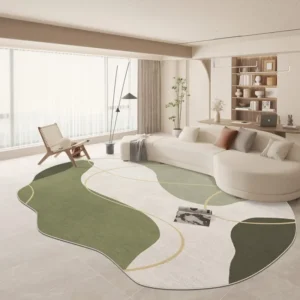 Large Area Green Rugs for Bedroom Nordic Living Room Decoration Shaped Carpet Irregular Plush Lounge Rug Home Thick Washable Mat
Rated 5.00 out of 5$54.94 – $346.41Price range: $54.94 through $346.41
Large Area Green Rugs for Bedroom Nordic Living Room Decoration Shaped Carpet Irregular Plush Lounge Rug Home Thick Washable Mat
Rated 5.00 out of 5$54.94 – $346.41Price range: $54.94 through $346.41 -
 Nordic Style Rugs for Bedroom Morandi Living Room Decoration Carpet Large Area Geometry Lounge Rug Home Cloakroom Non-slip Mat
Rated 5.00 out of 5$39.46 – $597.66Price range: $39.46 through $597.66
Nordic Style Rugs for Bedroom Morandi Living Room Decoration Carpet Large Area Geometry Lounge Rug Home Cloakroom Non-slip Mat
Rated 5.00 out of 5$39.46 – $597.66Price range: $39.46 through $597.66 -
 Irregular Shapes Living Room Decoration Carpet Modern Style Rugs for Bedroom Home Thicken Plush Rug Fluffy Soft Lounge Floor Mat
Rated 4.83 out of 5$55.84 – $347.37Price range: $55.84 through $347.37
Irregular Shapes Living Room Decoration Carpet Modern Style Rugs for Bedroom Home Thicken Plush Rug Fluffy Soft Lounge Floor Mat
Rated 4.83 out of 5$55.84 – $347.37Price range: $55.84 through $347.37

